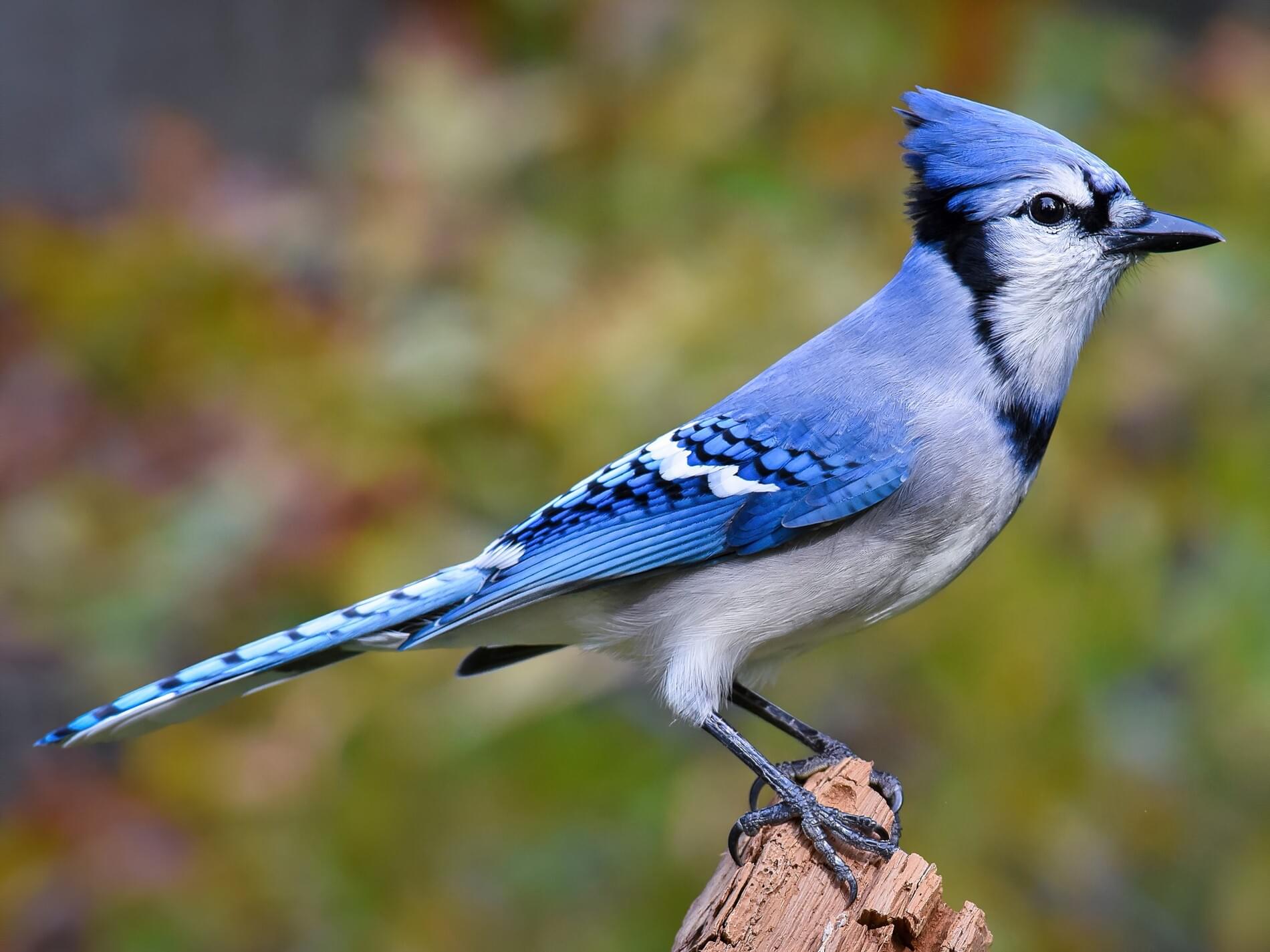Blue Jay Biology and Behavior: Blue Jays

The blue jay, a common sight in North American woodlands, is a fascinating bird with a striking appearance and complex social behavior. These intelligent birds are known for their loud calls, acrobatic flight, and distinctive plumage.
Physical Characteristics
Blue jays are easily recognizable with their bright blue, white, and black plumage. Their crest of feathers, which can be raised or lowered, adds to their striking appearance. Their bodies are about 10-12 inches long, with a wingspan of 15-18 inches. They have a short, stout bill, strong legs, and sharp claws.
Diet and Feeding Habits
Blue jays are omnivorous, meaning they eat a variety of foods. Their diet consists mainly of nuts, seeds, fruits, and insects. They are also known to scavenge for food and will readily consume carrion. They are particularly fond of acorns, which they often store for later consumption.
Role in the Ecosystem, Blue jays
Blue jays play an important role in the ecosystem. They are seed dispersers, helping to spread the seeds of various plants. They also consume insects, which helps to control insect populations.
Social Structure and Communication Patterns
Blue jays are highly social birds and live in flocks throughout the year. They have a complex system of communication, using a variety of calls and postures to convey information. Their calls can be loud and raucous, and they often mimic the calls of other birds. They are also known for their aggressive behavior, particularly during the breeding season.
Comparison with Other Birds
| Characteristic | Blue Jay | Crow | Robin | Cardinal |
|---|---|---|---|---|
| Size | Medium | Large | Small | Medium |
| Plumage | Blue, white, black | Black | Red breast, gray back | Red |
| Diet | Omnivorous | Omnivorous | Insects, worms | Seeds, fruits |
| Social Structure | Flocks | Flocks | Solitary | Pairs |
| Vocalizations | Loud, raucous | Cawing | Cheerful song | Whistling |
Blue Jays in Human Culture

The blue jay, with its striking plumage and boisterous calls, has captured the human imagination for centuries. It has become a symbol of various concepts and beliefs, finding its way into folklore, literature, art, and music. Understanding the blue jay’s cultural significance provides insights into how humans perceive nature and its inhabitants.
Symbolism and Mythology
The blue jay’s vibrant blue feathers have often been associated with spirituality and the divine. In Native American cultures, the blue jay is frequently depicted as a messenger, a trickster, or a symbol of wisdom. For example, the Iroquois people believe the blue jay to be a powerful spirit that can communicate with the gods. Similarly, the Cherokee people see the blue jay as a bringer of good fortune, while the Lakota believe it to be a guardian spirit that protects the people.
Folklore and Stories
Folklore surrounding the blue jay is rich and varied, often reflecting the bird’s bold and mischievous nature. In some stories, the blue jay is portrayed as a cunning trickster, outsmarting other animals or humans. For instance, in a Native American tale, a blue jay steals fire from the gods and brings it to humans. In other stories, the blue jay is depicted as a helpful creature, assisting humans in times of need. One story tells of a blue jay that leads a lost traveler back to safety.
Presence in Literature, Art, and Music
The blue jay’s distinctive appearance and behavior have inspired artists, writers, and musicians for generations. In literature, the blue jay has been used as a symbol of freedom, intelligence, and resilience. For example, in Henry David Thoreau’s “Walden,” the blue jay is described as a “free spirit” that embodies the beauty of the natural world. In art, the blue jay has been depicted in paintings, sculptures, and other forms of visual expression. The artist Georgia O’Keeffe, known for her close-up depictions of natural forms, often featured blue jays in her work, highlighting their unique beauty and grace. In music, the blue jay’s call has been incorporated into songs and compositions, often representing themes of nature, wilderness, and freedom.
Impact on Human Perceptions of Nature
The blue jay’s presence in human culture has significantly impacted our understanding and appreciation of nature. The bird’s bold and boisterous nature has often been seen as a symbol of wildness and freedom. Its vibrant colors and distinctive calls have made it a popular subject of observation and study. The blue jay has also played a role in promoting awareness of the importance of biodiversity and conservation. By studying the blue jay’s behavior and habitat, scientists can gain insights into the health of ecosystems and the impact of human activities on the natural world.
Conservation and Challenges

Blue jays, with their vibrant plumage and bold personalities, face a range of challenges that threaten their populations. While they are not currently considered endangered, understanding these threats is crucial to ensuring their continued presence in our ecosystems.
Habitat Loss
Habitat loss is a significant threat to blue jay populations. As human development encroaches on natural areas, forests are fragmented, and suitable nesting and foraging habitats are reduced. This loss of habitat directly impacts blue jays by limiting their food sources, nesting sites, and overall survival. For instance, the clearing of forests for agriculture, urbanization, and infrastructure development has led to a decline in suitable nesting sites and foraging grounds.
Climate Change
Climate change is another pressing challenge for blue jays. Warmer temperatures and altered weather patterns can disrupt blue jay breeding cycles and food availability. For example, a study published in the journal *Ecology* found that blue jays in warmer regions are experiencing earlier breeding seasons, which can lead to mismatches between food availability and chick development. Additionally, extreme weather events like droughts and wildfires can destroy nesting sites and reduce food resources, further impacting blue jay populations.
Conservation Efforts
Despite these challenges, there are ongoing efforts to protect blue jay populations.
Conservation Efforts
- Habitat restoration and protection: Organizations like the Audubon Society and The Nature Conservancy are working to restore and protect forests and other habitats essential for blue jays. These efforts involve reforestation projects, habitat management practices, and advocating for land conservation policies.
- Citizen science: Citizen science initiatives, such as the Cornell Lab of Ornithology’s Project FeederWatch, allow individuals to contribute valuable data on blue jay populations and distribution. This information helps researchers monitor blue jay trends and identify areas where conservation efforts are most needed.
- Education and awareness: Raising public awareness about the importance of blue jays and the threats they face is crucial for their conservation. Educational programs and outreach initiatives can encourage people to support habitat conservation and engage in responsible birdwatching practices.
Importance of Citizen Science
Citizen science plays a crucial role in blue jay conservation. By engaging the public in data collection and monitoring, citizen science initiatives provide valuable insights into blue jay populations and their distribution. This data helps researchers track changes in blue jay populations, identify areas where conservation efforts are most needed, and understand the impact of factors like habitat loss and climate change.
Blue jays, with their vibrant plumage and boisterous calls, are a familiar sight in many North American woodlands. Their intelligence and adaptability have made them a popular subject of study, much like the captivating rise of Enyel De Los Santos in the world of baseball.
De Los Santos, a pitcher with a similar blend of talent and determination, has shown a remarkable ability to adapt and excel, much like the blue jay navigating its complex environment.
